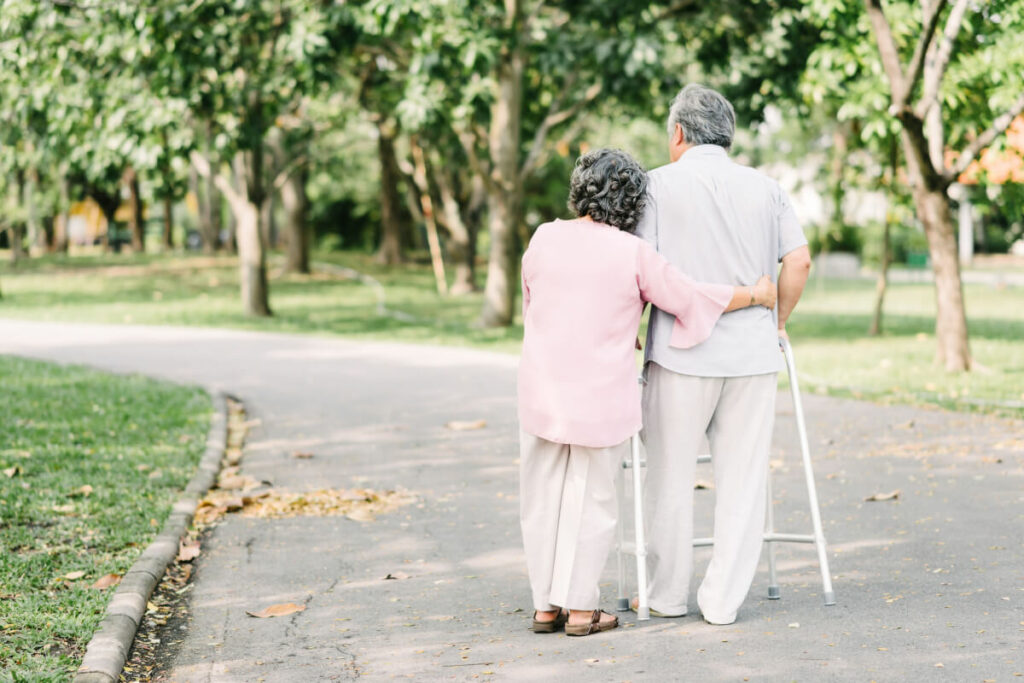Did you know that adults who participate in regular physical activity have a decreased risk of heart disease, type 2 diabetes, stroke, depression, and even early death? (2) With many people spending more time sitting during the day, such as while working, commuting, or watching television, it can be easy to spend too much time sitting and not enough time moving.
Sitting for prolonged periods of time may increase a person’s risk of blood clots, osteoporosis (decreased bone density), inflammation, premature aging, and more. (10) Thankfully, getting adequate exercise can be as simple as walking for ten uninterrupted minutes a day. (2) Read on to find out about the mental and physical health benefits of walking.
What are the health benefits of walking?
Below are some of the health benefits of walking.
1. Improves mental health and well-being
In 2018, a study evaluated the mental health benefits of walking 10,000 steps per day for 100 days. This study focused on the effects of walking on those with depression, anxiety, and stress, and looked at their overall well-being. They found that walking daily, even when participants didn’t reach 10,000 steps per day, benefited these mental health conditions with participants seeing decreased stress levels and improved anxiety and depression levels. (4)

2. Reduces the risk of chronic health conditions
In addition to the mental health benefits of walking, (4) regular physical activity can also improve physical health. Walking just 30 minutes a day, five days per week can reduce the risk of heart disease by approximately 20%. (12)
One meta-analysis (a study that examines the results of multiple independent studies of the same subject to determine overall trends) found that participants in outdoor walking groups showed significant improvements in blood pressure, resting heart rate, body fat and body weight, and cholesterol levels. (5) A brisk walk for 30 minutes per day has also been shown to reduce both blood glucose levels and insulin resistance, lowering the risk of type 2 diabetes by 30%. (9)

3. Prevents excessive weight gain
The health benefits of walking don’t end there. Walking may encourage weight loss and prevent excessive weight gain. One study followed participants who were deemed overweight or obese as they participated in a 16-week walking program. The study found that all participants’ body weight and waist circumference decreased. Not only that—participants also experienced improvements in muscle strength and flexibility! (16)
Do you struggle with a sweet tooth? A 15-minute walk can reduce chocolate cravings. (15)
4. Increases immunity
Walking can support immune health. Moderate exercise has been shown to have a positive, protective effect on the immune system, helping people avoid colds and flus. (1)
The health benefits of walking don’t only apply to young individuals; older people may also benefit. A study including 45 sedentary elders found that walking on a treadmill improved their innate immune systems. (6) According to the National Cancer Institute, innate immunity is the first response of the body’s immune system to a harmful foreign substance, like bacteria or viruses. (14)
5. Improves bone density
With less bone density and tissue, older people are at a greater risk of osteoporosis. (13) However, correcting calcium and vitamin D deficiency along with walking three to five miles every week has been shown to improve bone density in the hip and spine. (7)
A study done on postmenopausal individuals found that those who walk at least one mile per day have higher whole-body bone density than those who walk shorter distances. According to this same study, walking can also slow the rate of bone loss in the legs. (8)

6. May reduce the risk of breast cancer
Living an overall healthy lifestyle is important in order to feel our best. But living a healthy lifestyle that includes physical activity, such as walking, may reduce the risk of breast cancer. (11)
A study found that the female participants who engaged in physical activity for 7.5 MET-hours per week had a 6% less chance of developing breast cancer. The Physical Activity Guidelines for Americans, 2nd edition defines MET as “a unit useful for describing the energy expenditure of a specific activity. A MET is the ratio of the rate of energy expended during an activity to the rate of energy expended at rest.” (3) Those who participated in 15 hours of physical activity per week had a 10% less chance. (11)
The bottom line
The health benefits of walking daily can help you maintain a healthy lifestyle. One of the biggest advantages of walking as a form of exercise is accessibility. You don’t need a costly gym membership, expensive equipment, or a personal trainer’s knowledge of movement in order to participate in walking. No matter your age and fitness level, all you have to do is put on a pair of comfortable shoes and step outside or onto a treadmill.
- Brolinson, P. G., & Elliott, D. (2007, July). Exercise and the Immune System. Clinics in Sports Medicine, 26(3), 311–319.
- CDC VitalSigns – More People Walk to Better Health. (2013, August 6). Centers for Disease Control and Prevention. https://www.cdc.gov/vitalsigns/walking/
- Department of Health and Human Services. (2018). Physical Activity Guidelines for Americans: 2nd edition. https://health.gov/sites/default/files/2019-09/Physical_Activity_Guidelines_2nd_edition.pdf
- Hallam, K. T., Bilsborough, S., & de Courten, M. (2018, January 24). “Happy feet”: evaluating the benefits of a 100-day 10,000 step challenge on mental health and wellbeing. BMC Psychiatry, 18(1).
- Hanson S, Jones AIs there evidence that walking groups have health benefits? A systematic review and meta-analysisBritish Journal of Sports Medicine 2015;49:710-715.
- Hassan, S., & Mehani, M. (2016). Innate immunity response to treadmill walking exercise in elderly. Cairo University, 16(2). http://lib.pt.cu.edu.eg/7-Sherin%20Hassan%20July%202011.pdf
- Karaguzel, G., & Holick, M. F. (2010, December). Diagnosis and treatment of osteopenia. Reviews in Endocrine and Metabolic Disorders, 11(4), 237–251.
- Krall, E. A., & Dawson-Hughes, B. (1994, January). Walking is related to bone density and rates of bone loss. The American Journal of Medicine, 96(1), 20–26.
- Ley, S. H., Ardisson Korat, A. V., Sun, Q., Tobias, D. K., Zhang, C., Qi, L., Willett, W. C., Manson, J. E., & Hu, F. B. (2016, September). Contribution of the Nurses’ Health Studies to Uncovering Risk Factors for Type 2 Diabetes: Diet, Lifestyle, Biomarkers, and Genetics. American Journal of Public Health, 106(9), 1624–1630.
- Lurati, A. R. (2017, December 18). Health Issues and Injury Risks Associated With Prolonged Sitting and Sedentary Lifestyles. Workplace Health & Safety, 66(6), 285–290.
- Matthews, C. E., Moore, S. C., Arem, H., Cook, M. B., Trabert, B., Håkansson, N., Larsson, S. C., Wolk, A., Gapstur, S. M., Lynch, B. M., Milne, R. L., Freedman, N. D., Huang, W. Y., Berrington de Gonzalez, A., Kitahara, C. M., Linet, M. S., Shiroma, E. J., Sandin, S., Patel, A. V., & Lee, I. M. (2020, March 1). Amount and Intensity of Leisure-Time Physical Activity and Lower Cancer Risk. Journal of Clinical Oncology, 38(7), 686–697.
- Murtagh, E. M., Murphy, M. H., & Boone-Heinonen, J. (2010, September). Walking: the first steps in cardiovascular disease prevention. Current Opinion in Cardiology, 25(5), 490–496.
- NCI Dictionary of Cancer Terms. (n.d.-c). National Cancer Institute. https://www.cancer.gov/publications/dictionaries/cancer-terms/def/osteoporosis
- NCI Dictionary of Cancer Terms. (n.d.). National Cancer Institute. https://www.cancer.gov/publications/dictionaries/cancer-terms/def/innate-immunity
- Oh, H., & Taylor, A. H. (2013, December). A brisk walk, compared with being sedentary, reduces attentional bias and chocolate cravings among regular chocolate eaters with different body mass. Appetite, 71, 144–149.
- Son, S., Jeon, B., & Kim, H. (2016). Effects of a walking exercise program for obese individuals with intellectual disability staying in a residential care facility. Journal of Physical Therapy Science, 28(3), 788–793.




